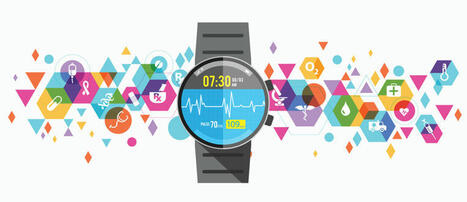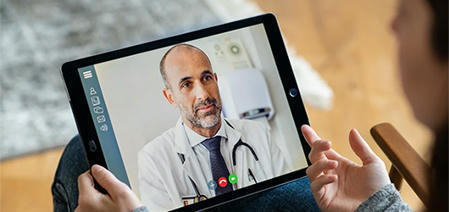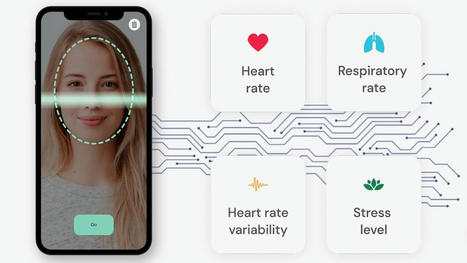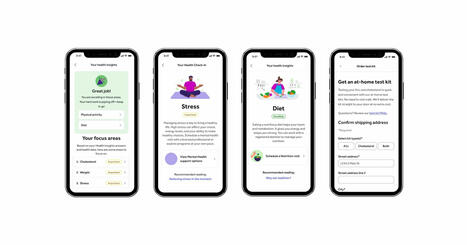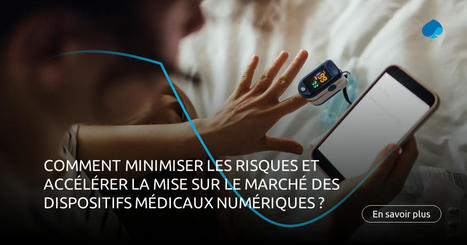 Your new post is loading...
 Your new post is loading...

|
Scooped by
Beeyond
April 21, 12:13 PM
|
L’essor de l’intelligence artificielle, du Big Data, de la blockchain et de la télémédecine ouvre de nouvelles perspectives pour une médecine plus personnalisée, efficace et accessible. La digitalisation n’est plus une option mais une nécessité stratégique pour améliorer l’efficacité des soins.

|
Scooped by
Beeyond
April 20, 5:43 PM
|
The CT-132 prescription digital therapeutic is indicated for the preventive treatment of episodic migraine in patients 18 years of age and older. It is intended for adjunctive use alongside acute and / or other preventive treatments for migraine. The FDA’s decision was primarily based on compelling data from the pivotal ReMMi-D (Reduction in Monthly Migraine Days, NCT05853900) study. This study evaluated CT-132 in patients already taking standard-of-care prescription migraine medications (including acute, first-line preventive, and second-line preventive treatments) and successfully met its primary endpoint of significantly reducing monthly migraine days.

|
Scooped by
Beeyond
March 4, 10:04 AM
|
Moving forward, it’s essential for the health tech and medical fields to work together to make remote patient monitoring much more widely available and affordable for everyone across the country, with and without insurance.

|
Scooped by
Beeyond
February 28, 11:43 PM
|
Despite the availability of customized coverage, 30% of healthcare clients were unaware additional coverage existed and thus did not purchase it, brokers reported. Consequently, more than eight in 10 brokers (84%) are concerned that some clients may be operating their business without the appropriate coverage for digital health services. This could stem from various factors, such as changes in a client's business model or an expansion of their geographic footprint to provide services in different states. Meanwhile, claims related to digital health services have risen over the last year, with 60% of brokers noting an increase.

|
Scooped by
Beeyond
June 16, 2024 10:19 AM
|
According to the press release, court documents noted that He and Brody allegedly conspired to provide easy access to Adderall as well as other stimulants. Drug seekers were targeted through deceptive ads on social media. By limiting information to Done prescribers, drugs were prescribed to members, who paid a monthly subscription fee, even if they didn’t qualify. Refills were put on auto-refill to maximize profits, and follow-ups were discouraged by refusing payment to Done prescribers for consultations after the first appointment.

|
Scooped by
Beeyond
March 4, 2024 2:39 AM
|
Sustainable activity startup Walk15 is launching a steps prescription pilot with the Šeškinės clinic in Vilnius

|
Scooped by
Beeyond
February 17, 2024 9:07 AM
|
A new EY survey found that while 86% of health executives say that digital health solutions have the potential to reduce costs, 70% said they haven’t seen a return on investment so far.

|
Scooped by
Beeyond
December 24, 2023 10:23 AM
|
Researchers at the University of Arizona are trying to close the digital healthcare gap with their new wearable device. The device can send health data up to 15 miles, without any significant infrastructure.

|
Scooped by
Beeyond
December 24, 2023 10:21 AM
|
Execs overwhelmingly cite genAI as having the most significant impact in healthcare this year, though others provide alternative takes on the years' events.

|
Scooped by
Beeyond
December 20, 2023 1:04 PM
|
Un arrêté publié au Journal officiel le 16 janvier fixe les nouvelles conditions de prise en charge de l’appareil de pression positive continue (PPC). Les dispositifs que reçoivent désormais les patients souffrant d’apnée du sommeil sont équipés d’un système de télésurveillance qui permet de mesurer le temps d’utilisation de la machine. Il faudra que le malade y ait recours au moins trois heures par tranche de vingt-quatre heures pendant vingt jours pour pouvoir prétendre à sa prise en charge (tous les nouveaux patients sont concernés et tous le seront d’ici 2016). Si au bout de trois mois, il est constaté une sous utilisation du dispositif, le remboursement sera diminué de moitié et interrompu totalement à la fin du cinquième mois.

|
Scooped by
Beeyond
December 20, 2023 12:50 PM
|
Téléconsultations, appareils médicaux connectés, dossiers patients dématérialisés : la multiconnectivité est aujourd’hui indissociable de l’e-santé. Demain, la combinaison de réseaux robustes et d’outils de data intelligence permettra d’améliorer encore davantage le suivi patient. Tour d’horizon des grandes tendances e-santé.

|
Scooped by
Beeyond
December 20, 2023 12:47 PM
|
Through the collaboration, Enovacom technology automatically integrates patient data from multiple hospital and healthcare IT systems into a cloud-based data safe haven, using a trustworthy research environment hosted by AIMES. This virtual data repository saves hundreds of hours of NHS clinical research staff time by using streamlined data flows to make access easier and quicker, and removing the need for manual data sharing.

|
Scooped by
Beeyond
December 13, 2023 4:58 AM
|
This is the first CE-certified Medical Device tech, to use a video selfie to measure vital signs for telemedicine, health prevention, and overall well-being.
|

|
Scooped by
Beeyond
April 20, 5:44 PM
|
Teladoc Health has launched an enhanced Cardiometabolic Health Program to address rising rates of cardiometabolic disease and support healthier behaviors across diet, activity, sleep, stress, weight, blood pressure, glucose, lipids, and nicotine exposure. Aligned with the American Heart Association’s Life’s Essential 8, the program combines virtual care, data-driven insights, and behavior change to improve outcomes and prevent disease progression.

|
Scooped by
Beeyond
April 19, 12:14 PM
|
Through Teladoc's new cardiometabolic health program, patients gain access to the BetterSleep app, a registered dietitian, health coaches, at-home testing and more.

|
Scooped by
Beeyond
February 28, 11:45 PM
|
A doctor’s visit not long ago meant carving hours out of a busy schedule and then spending much of that time in a waiting room. Today, healthcare is coming out of traditional care delivery models from the confines of hospital walls. Alternate care delivery models—led by telehealth, remote monitoring and digital-first clinics—transform how and where patients receive care.

|
Scooped by
Beeyond
November 25, 2024 8:57 AM
|
There was no difference in edoxaban adherence between the groups. However, the proportion of adequate medication adherence was higher in the intervention group, and the benefit of the smartphone app–based intervention on medication adherence was more pronounced among older patients than among younger patients. Given the low adherence to oral anticoagulants, especially among older adults, using a smartphone app may potentially improve medication adherence.

|
Scooped by
Beeyond
April 1, 2024 6:13 AM
|
« Défaut logiciel », « envoi de fausses alertes », « erreur de firmware », « erreur de connexion », « bugs » « capteur défectueux », « vulnérabilités de cybersécurité »… La liste des produits rappelés par la FDA en raison de leur logiciel est éloquente. Chaque fois, pourtant, on devine aisément comment les choses se sont passées : des équipes qui n’ont pas compté leurs heures pour concevoir et fabriquer le nouveau dispositif, une assurance qualité qui a tout examiné minutieusement, des ajustements jusqu’à la dernière minute, l’euphorie, enfin, lorsque le travail a semblé achevé… Et pendant tout ce temps, quelque part, subsistait une imperceptible faille qui a réduit tout ces efforts à néant, compromettant la sécurité du système et soulevant du même coup la question des responsabilités.

|
Scooped by
Beeyond
February 21, 2024 11:31 AM
|
About 57% of patients have gone to a doctor’s appointment to discover that the provider was not the right one for their condition, according to new research from Zocdoc. Because of this, the company launched a new tool called Guided Search that helps pair patients with the correct provider.

|
Scooped by
Beeyond
December 24, 2023 10:24 AM
|
CB Insights released a list of what it deems to be the 50 most promising digital health companies of 2023. The market research firm said that the startups on the list are working to improve four main aspects of healthcare: personalization, efficiency, equity and accessibility.

|
Scooped by
Beeyond
December 24, 2023 10:22 AM
|
“Regarding the ethical obligation of consent in digital health, respect for individuals, with an emphasis on their right to autonomy and self-determination, is fundamental to ethical medical research and practice,” the researchers of the study wrote. “While conventional consent practices have been historically accepted, they have struggled in rapidly evolving digital health environments.”

|
Scooped by
Beeyond
December 20, 2023 1:39 PM
|
Smartphones offer us incredible new opportunities for implementing efficient clinical research trials. They allow researchers to simplify complexities that have traditionally surrounded clinical research with tools that are now easily accessible to both practitioners and patients. Smartphones can be used to gather critical information from an enrolled patient including factors such as weight, blood pressure, glucose levels, and more. Not only can smartphones be used to automate and speed up information entry, they offer ways to improve the methodology and accuracy of research.

|
Scooped by
Beeyond
December 20, 2023 1:02 PM
|
Deux arrêtés datés du 9 janvier et du 22 octobre 2013 avaient fixé les nouvelles conditions de prise en charge des appareils de pression positive continue (PPC). Grâce à un système de surveillance équipant tous les nouveaux appareils et destiné à être mis en place auprès des patients dès 2016, l’utilisation par le malade du dispositif devait être contrôlée. Il était prévu que pour pouvoir prétendre à sa prise en charge, le patient y ait recours au moins trois heures par tranche de vingt-quatre heures pendant vingt jours. Si au bout de trois mois, il était constaté une sous utilisation du dispositif, le remboursement aurait dû être diminué de moitié et interrompu totalement à la fin du cinquième mois. Le patient aurait dû alors s’acquitter seul du paiement des 20 euros par semaine. Cette solution était destinée à apporter une réponse à un phénomène suspecté depuis longue date : on estime qu’au moins 20 % des patients sous PPC n’utilisent pas correctement leur appareil, ce qui suscite une dépense « non justifiée » de 80 millions d’euros par an par l’Assurance maladie.

|
Scooped by
Beeyond
December 20, 2023 12:50 PM
|
Founded in 2019 by three intensive care professionals, Clinomic is a German company specialized in smart solutions for acute and critical care. In just a few years, Clinomic has improved the daily lives of caregivers in Europe thanks to its various innovations, especially in the field of telemedicine and digitization of care.

|
Scooped by
Beeyond
December 20, 2023 12:45 PM
|
Dès aujourd’hui, les activités B2B d’Orange Healthcare sont transférées au sein d’Enovacom. Fort d’un effectif de 250 personnes, ce pôle unique permet d’accélérer les synergies et d’accompagner le virage numérique de la Santé. Avec un siège social Marseillais, ce regroupement s’intègre également dans la volonté du Groupe de renforcer ses activités stratégiques en région, au plus près des acteurs des territoires et des talents. Un plan de recrutement ambitieux accompagne cette transformation.
|

 Your new post is loading...
Your new post is loading...
 Your new post is loading...
Your new post is loading...






